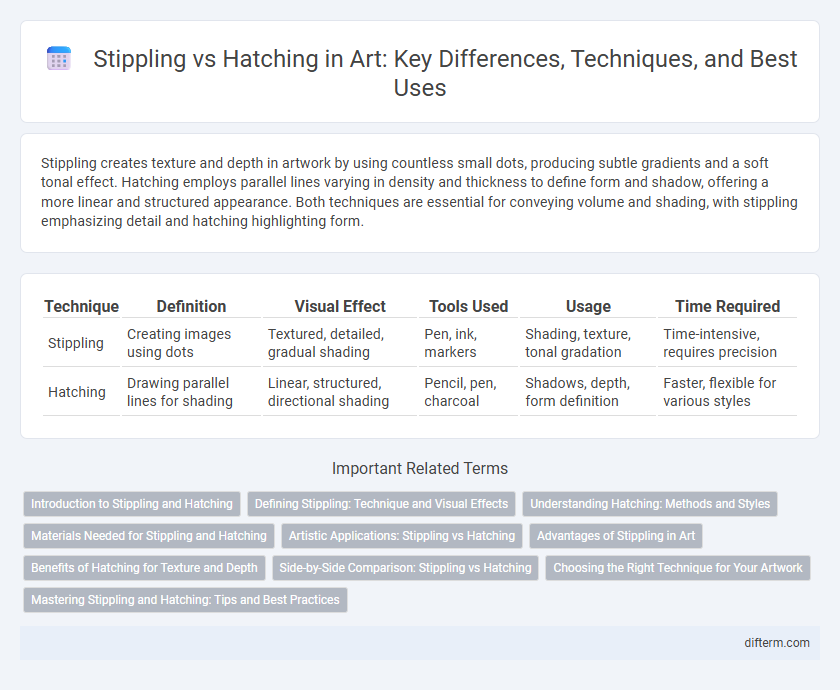Stippling creates texture and depth in artwork by using countless small dots, producing subtle gradients and a soft tonal effect. Hatching employs parallel lines varying in density and thickness to define form and shadow, offering a more linear and structured appearance. Both techniques are essential for conveying volume and shading, with stippling emphasizing detail and hatching highlighting form.
Table of Comparison
| Technique | Definition | Visual Effect | Tools Used | Usage | Time Required |
|---|---|---|---|---|---|
| Stippling | Creating images using dots | Textured, detailed, gradual shading | Pen, ink, markers | Shading, texture, tonal gradation | Time-intensive, requires precision |
| Hatching | Drawing parallel lines for shading | Linear, structured, directional shading | Pencil, pen, charcoal | Shadows, depth, form definition | Faster, flexible for various styles |
Introduction to Stippling and Hatching
Stippling and hatching are fundamental art techniques used to create texture, depth, and shading by varying the density and pattern of marks. Stippling involves placing numerous small dots closely together to form gradients and intricate detail, emphasizing precision and control. Hatching employs parallel or crosshatched lines to build tone and volume, offering dynamic variation through line direction and spacing.
Defining Stippling: Technique and Visual Effects
Stippling is an art technique involving the application of numerous small dots to create texture, shading, and tonal variation, producing a nuanced and detailed visual effect. Artists vary dot density and size to control light, shadow, and depth, making stippling ideal for highly detailed and realistic illustrations. This method contrasts with hatching, which uses lines; stippling's granular approach achieves a softer, more gradual transition between tones.
Understanding Hatching: Methods and Styles
Hatching is a drawing technique that uses closely spaced parallel lines to create shading and texture in artwork. Different hatching styles include parallel hatching, cross-hatching, contour hatching, and tick hatching, each varying in line direction and density to achieve diverse tonal effects. Mastering hatching methods enhances the depth, dimension, and realism in pen-and-ink drawings and sketches.
Materials Needed for Stippling and Hatching
Stippling requires fine-tipped pens or brushes and smooth paper to create precise dot patterns, emphasizing control and consistency. Hatching benefits from a variety of pencils, pens, or ink tools and textured paper that allows for varied line density and shading effects. Both techniques demand quality materials to achieve detailed and dynamic artwork through their distinct mark-making methods.
Artistic Applications: Stippling vs Hatching
Stippling and hatching are distinct artistic techniques that create texture and depth using dots and lines, respectively. Stippling offers precise control for subtle gradations and intricate detailing, making it ideal for fine portraits and botanical illustrations. Hatching provides dynamic shading and directional emphasis, often used in sketches and expressive drawings to convey movement and form.
Advantages of Stippling in Art
Stippling in art offers unparalleled control over tonal variation and texture through the use of numerous small dots, allowing for smooth gradations and subtle shading. This technique enhances depth perception and detail accuracy without harsh lines, making it ideal for intricate illustrations such as botanical or anatomical drawings. Artists favor stippling for its ability to create a soft, organic feel that complements fine pen and ink work, distinguishing it from the more linear and structured appearance of hatching.
Benefits of Hatching for Texture and Depth
Hatching enhances texture by varying line density and direction, creating intricate patterns that mimic surfaces and materials in art. This technique provides depth through controlled shading, allowing artists to convey light and shadow with precision. Hatching's versatility supports dynamic compositions, making it ideal for emphasizing form and dimension in detailed drawings.
Side-by-Side Comparison: Stippling vs Hatching
Stippling and hatching are both shading techniques used to create texture and depth in artwork, with stippling relying on numerous small dots while hatching uses parallel lines. Stippling offers greater control over tonal gradation through dot density, making it ideal for subtle shading, whereas hatching can convey direction and form more dynamically via varying line length and proximity. Artists often choose stippling for detailed, realistic renderings and hatching for expressive or gestural effects, highlighting their complementary roles in fine art.
Choosing the Right Technique for Your Artwork
Stippling and hatching are essential techniques in art, each offering unique textures and depth through dot clusters or parallel lines respectively. Stippling excels in creating smooth gradients and subtle shading, ideal for detailed, realistic works where fine control over light and shadow is needed. Hatching provides dynamic line variation and movement, making it suitable for expressive, graphic styles and emphasizing form through direction and density of marks.
Mastering Stippling and Hatching: Tips and Best Practices
Mastering stippling and hatching techniques enhances texture and depth in artwork by strategically placing dots or lines. Consistent spacing in stippling creates smooth gradients, while varying line direction and thickness in hatching builds dynamic shading. Practicing controlled hand movements and studying light sources significantly improves precision and realism in both methods.
Stippling vs Hatching Infographic

 difterm.com
difterm.com